World Fine Art Professionals and their Key-Pieces, 206 - Harry van der Woud
World Fine Art Professionals and their Key-Pieces, 206 – Harry van der Woud
The studio of Harry van der Woud looks like a Wunderkammer. I see various stuffed animals: a gull, an owl, an ermine, a fox skin on a black male body. There are various skulls in between. A cupboard full of sketchbooks in which he recorded his daily experiences in drawings, ideas, finds from the street. And on the left of me on the wall objects that he has put together, the background is their own photographic shadow. He calls them made ready’s, they’re not ready mades, although everything is found on the street as befits a street comber, but they resurrect themselves, according to the artist “I must be ready for it”.
Leipziger Schule
The artist studied in Groningen, the Netherlands, at the Minerva Academy, known at the time as an exponent of realism. His paintings are technically and in terms of material expression at a very high level, but Harry van der Woud does give his own interpretation to that realism.
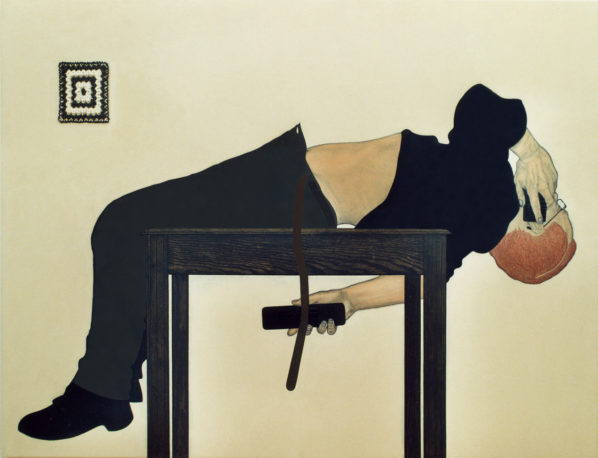
harry van der woud – 3, Self-portrait on table – oil-acrylic paint-ink-cloth-plastic-canvas – 130 x 170 cm
Harry van der Woud: “Realism has never been a goal for me, but a tool. My realism is not just about what you see, what doesn’t seem tangible is all the more present. For the observer a completely different interpretation can prevail at the moment of viewing which is inspiring to me.” He feels akin to the realists of the Leipzig School. Not so long ago, the work of a representative, Neo Rauch, was shown in Museum de Fundatie in Zwolle. “Unfortunately, such a movement did not take off here, I did plead for it more then once, a movement that has its roots in realism such as the Leipziger Schule, in this case Groningen, which distinguishes itself from traditional realism. Minerva is often associated with it. However, in Groningen, as in Leipzig, you had artists/teachers like Barend Blankert, with whom I became friendly and talked a lot about art in the pub, who are rather conceptual, realism is a stylistic device to them as well.”
Balance
Van der Woud’s paintings are life size. We often see a strongly similar main character as a central figure. The individual is depicted in uncomfortable situations. The face and attitude betray many conflicting emotions. Often the figure is on/under/next to a table. “The table is a recurring element, it is a setting where people philosophize, are lost in thought, eat, drink, come to an agreement, bridge differences or become frustrated. A communicative factor pur sang.”
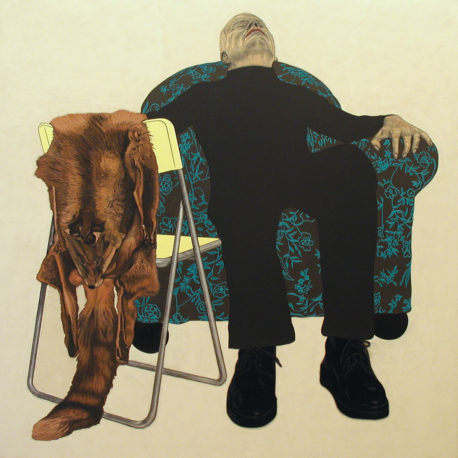
harry van der woud – 5, The distance you radiate is extremely attractive said one planet to another – oil-acrylic-enamel paint-charcoal-canvas –
Harry brings a number of paintings to the working space of the studio and puts them against or on the wall. It’s about the balance he says. “An impossible position that can hardly be sustained but can last forever on a painting”. One can see. He clings under the table, bites like a dog in the edge of the table, he sits on his knees on the table, his belly is snakeskin, the saliva comes out of his mouth, he lifts up his left leg. He lies on the table with a telephone in one hand, the remote control in his other hand, and his pants are open. He grabs a moose with large horns by the mouth. On the bottom left a purgatory is shown. In another work he is a martyr strangling himself. What’s going on?
Escape
Harry: “I use myself as a model. You’re always around when researching the endlessly varied human nature.” Although there is also a kind of fictional calm on the canvases, you know and feel it won’t last long. “All art that affects me is essentially about escape.”
“I escaped my birthplace Leeuwarden by going to Groningen, to Minerva. At that time I was post-punk, new wave, recalcitrant and shy, a complex combination. At first the Academy was a disappointment, the structure was rigorous. After a few years it became looser and you could choose your own direction. Of course there were the traditional realists, but also their natural counterparts like Ruud de Rode and Johan van Oord, I experienced the freedom there I expected to find earlier. ”
After a few years, he graduated and worked in his studio in the center of Groningen, this closed in on him too. “Groningen is a nice city, but after a while you notice that a certain subculture predominates. This is impossible in Amsterdam, there is not one subculture, but there are many subcultures existing next to each other. More breathing space on the whole. In Amsterdam you are anonymous, which feels good, it is possible to submerge here. ”
Where does that escape instinct come from? “If I did not escape, I would go crazy. I converted myself to being unworldly, for the world is stranger to me than ever. I can only observe in wonder. In order not to go mad, it can’t be crazy enough. Art is madness for the connoisseur. What is weird when man possesses the imaginative power to depict? An artist brings things into the world that aren’t there yet or asked for but want to be there. This is not easy, although the usefulness of art is obvious to me, it’s often really recognized afterwards. This is why I try to bring it out in the open as subtly and elegantly as possible as there is more then enough junk. For example, where do all those unguided words go to, catapulted into space every day? Unprepared and unhealed, they float like parasites in search of a host, I want to be that host. Art is a magnet that attracts morality, the image does the work. The artist is the leader of a group that doesn’t exist.”
Two Yellow Ikea Chairs
Harry van der Woud does not have a particular key work, he says. “Every new work is a key work as you try to transcend your own limitations time and time again to look behind what you know and thus unlock the universe.” Although there is not a certain key work, during the conversation he shows me the painting ‘Two Yellow Ikea Chairs’, published in the magazine Tableau * on the eve of Art Amsterdam where he exhibited with his former gallery Artipoli. You can see him lean back on a yellow Ikea chair in a stretched position with his hand on the table. Under his arm there is another chair, bottom up. “On the basis of the publication it was already sold before it was on show. The collector, founder of the museum No Hero ** wanted it to be on Art Amsterdam as planned, then it went viral on the so-called social media.”
With another painting ‘Homini Lupus’ he participated in the Europe prize for painting in Belgium in 2000. His work was shown in Moscow at the Pushkin Museum in the exhibition ‘The Magic of Dutch Realism’ ***. Together with work by, among others, Pyke Koch. The basis of the exhibition was the ING collection, his work was purchased by Annabelle Birnie, then head of art affairs and Sanne ten Brink, now head curator at ING Art Management.
Gifts
The paintings are becoming more and more perfect in terms of depiction, more materialized, as Harry calls it. “Sometimes I get presents. On one of the paintings I integrated the reflection of the luxaflex that was visible during a short period of time. In another painting I suddenly saw a cross. It was absolutely unintentional. You get those kinds of gifts when you’re working very concentrated. Art is an experiment and exploration simultaneously. Suddenly everything fits. That feels just great. Serendipity it is also called. Alexander Fleming invented the penicillin in this way. He was looking for a new drug and when he couldn’t find a solution, he let his attempts be for a while. Fungus started to grow. That fungus was the raw material for the penicillin. The solution was in that fungus. Things are already there, but not yet seen.”
What does this tribe want? Plenty of good, that’s for sure.
I look at the left wall where his tribe as he calls them is represented. On the table there are also a few under a glass bell. He points to a reading lamp “A few of them already resurrected with me in the role of Dr. Frankenstein, the light gave them great shadows and that’s how I started photographing at night with a small bicycle light, you can manipulate the light very nicely. Suddenly I knew how I could present them. I use the basic means of photography, light and shadow to bring a forgotten tribe to life. As a painter it is completely logical for me to use the literal meaning of the word photography, to draw with light. This tribe, whose body parts had spread over city and country, discarded, unsuspectingly trampled under many shoes, in this way regains its identity and gets unthought-of characteristics under the influence of being in the spotlights. I showed them during This Art Fair **** at the Beurs van Berlage and they caught the eye of the visitors. Young and old. It unleashed their imagination. They have no title, so they associated freely. It is a kind of oxygen for the mind, also for me, a state in which your thoughts do not play with you but you are playing with your thoughts.” He also lets them move digitally and by now they find their way in the diaspora.
Sponge
Does he have a suitable philosophical conclusion? “My artistic philosophy is that of the sponge. A filter is lacking so everything is perceived unfiltered. Sketchbooks are my second hard drive and catalyst. If the absorptive ability stops with an overflowing brain as a result, the fisherman must select the salmon that is suitable for consumption.”
Images
1) photo artist, 2) Self-portrait with table – oil-acrylic paint-ink-canvas – 140 x 160 cm, 3) Self-portrait on table – oil-acrylic paint-ink-canvas-plastic-canvas – 130 x 170 cm, 4) Self-portrait as martyr – oil-acrylic-enamel paint-canvas – 140 x 160 cm, 5) The distance you radiate is extremely attractive one planet to another – oil-acrylic-enamel paint-charcoal -canvas – 160 x 160 cm, 6) 6. Hold me now – oil-acrylic paint-canvas – 150 x 120 cm, 7) Conviction – oil-acrylic paint-ink-canvas – 150 x 160 cm, 8) Deus ex machina – oil-acrylic paint-ink-canvas – 170 x 160 cm, 9) What about # 62 & 54 – 16x8x4 cm, 10) What about # 50-38-53-60 18x12x5 cm
http://www.harryvanderwoud.nl/
*http://www.harryvanderwoud.nl/index.php?fuseaction=home.showPages&pagenr=1&item=1&taal=
**https://museumnohero.nl/
***https://bit.ly/2TFKslm
****http://thisartfair.com/artist/harry-van-der-woud/
https://ifthenisnow.eu/nl/verhalen/de-wereld-van-de-amsterdamse-kunstenaar-52-harry-van-der-woud
Disclaimer: The views, opinions and positions expressed within this guest article are those of the author Walter van Teeffelen alone and do not represent those of the Marbella Marbella website. The accuracy, completeness and validity of any statements made within this article are not guaranteed. We accept no liability for any errors, omissions or representations. The copyright of this content belongs to Walter van Teeffelen and any liability with regards to infringement of intellectual property rights remains with the author.

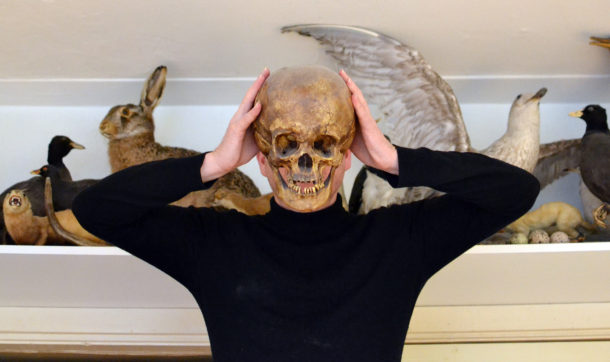
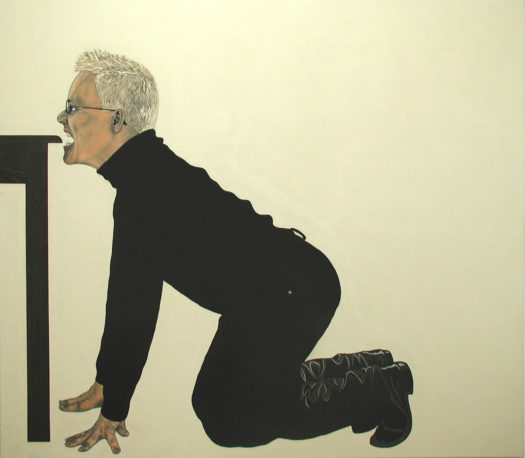
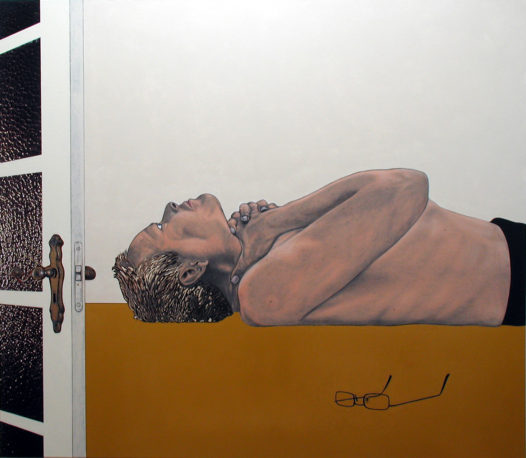
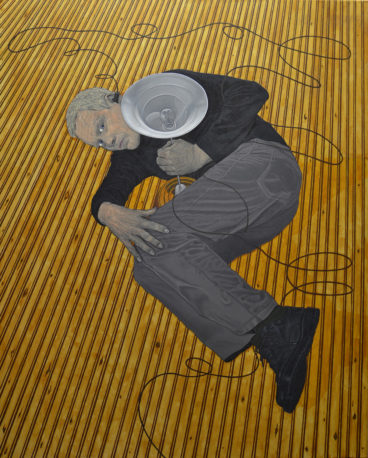
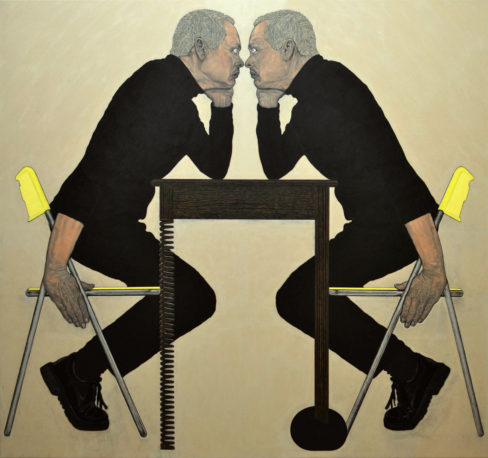

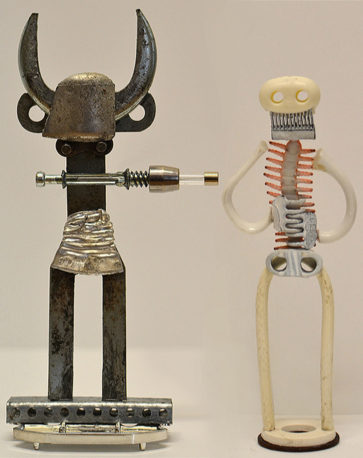
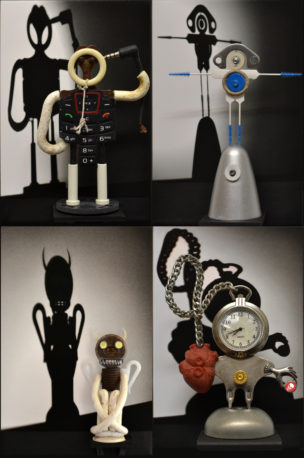














The opinions expressed by individual commentators and contributors do not necessarily constitute this website's position on the particular topic.